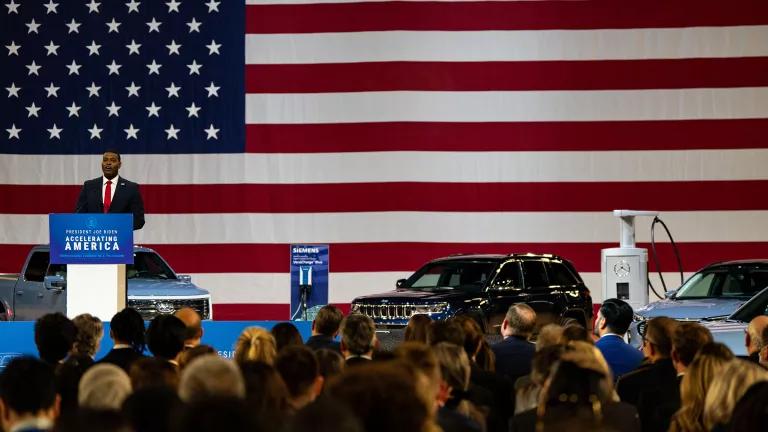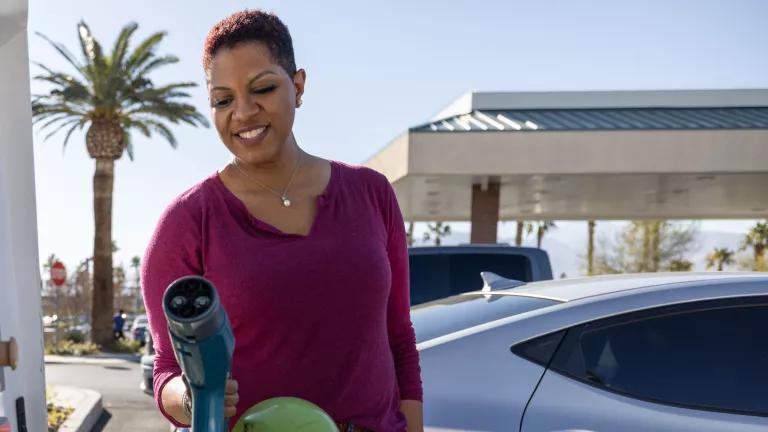
As Minnesotans continue to stay-at-home to flatten the COVID curve, the state government is working hard to support healthcare providers, assist workers and businesses, and to keep the public safe and healthy in these unprecedented times. In the face of the pandemic, state officials delayed publication of draft Clean Cars standard temporarily to ensure the public has adequate time to review and give input. But now the oil industry wants this delay to continue indefinitely – forever, if possible. We cannot let that happen; there are plenty of economic, health and climate reasons to make these protective standards a reality.
This is in stark contrast to actions by the Trump administration which, in the middle of a global public health pandemic, rolled back clean car and fuel economy standards that were protecting public health and helping cut fuel bills. As my colleague has written, the rollbacks will cost consumers across the country an additional $176 billion at the pump while giving a license to automakers to make vehicles that pollute more. That’s unfortunate, as studies are showing that more polluted air is contributing to higher COVID-19 death rates, as my colleague and environmental health scientist explains. As a Harvard study found, these “results underscore the importance of continuing to enforce existing air pollution regulations to protect human health both during and after the COVID-19 crisis.”
In a diabolic twist, the oil industry and their allies are pushing agencies to suspend enforcement or delay rules meant to reduce air pollution and protect public health and air pollution rules.
Minnesota Ready to Set Protective Standards
Fortunately, last September Minnesota Gov. Tim Walz directed the Minnesota Pollution Control Agency to implement a Clean Cars standard in Minnesota, joining 14 other states that represent 36% of the U.S. car-buying market and that have already adopted similar emission standards for passenger vehicles. The state would also be joining 11 of those states in adopting requirements to increase availability and sales of electric vehicles in the state. As Gov. Walz noted, "If Washington won’t lead on climate, Minnesota will. That is why we are taking bold action to reduce carbon emissions in a way that increases car options, protects public health, creates jobs, and saves Minnesotans money at the pump.”
By a two-to-one margin, Americans support allowing states to set stronger tailpipe standards than the federal government, according to a December poll by the Washington Post.
A Win-Win-Win for the Economy, Public Health, and Jobs
Consumers Union estimates that the Trump administration’s rollbacks will mean consumers on average will spend about $3,200 more on fuel per vehicle over the lifetime of their vehicles. When adopted, Minnesota’s program will help protect consumers from paying more at the pump by increasing the availability and deployment of cleaner, more fuel-efficient vehicles by automakers. In addition, the program would require automakers to make more electric vehicles available for sale in the state, resulting in electrified versions of crossovers, SUVs, and even light trucks. At a time when every penny counts, Minnesota’s program would be the single biggest policy to reduce transportation costs for households across the state.
Residents who don’t own an electric vehicle will also benefit from the lower cost of electricity for everyone. A study completed by MJ Bradley and Associates in 2018 projected that savings from increased electric vehicle (EV) adoption in Minnesota could result in up to $103 million in bill reduction benefits to all electric ratepayers through 2030, regardless of whether or not they own an EV. This is because EVs are generally charged during the hours of the day when there is spare capacity on the electric grid, which means additional revenue from EV charging will be generated by utilities which automatically go back to all Minnesotans under the rules.
Public Health Will be The Winner
Pollution from vehicles as well as extracting, refining, and transporting gasoline is incredibly harmful to respiratory health. Low-income communities and communities of color – often located close to freeways – bear a disproportionate brunt of that damage. Similarly, those same emissions can harm vulnerable groups including children and teenagers, older adults, and those with pre-existing conditions such as asthma, cardiovascular disease, or bronchitis. At a time like this, we don’t need more hospital admissions that are preventable.
The Oil Industry Isn’t Happy
Together the enormous reductions in gasoline expenditures, the downward pressure on utility rates, and investments in charging infrastructure will mean more money stays in the hands of Minnesotans than being handed over to out-of-state oil companies.
It comes as no surprise that oil industry lobbyists are unhappy. They’ve now teamed up with the Koch-brother funded group, the Center for American Experiment, to oppose clean car standards. The lobbyists have tried to sow fear and doubt in the Minnesota legislature through disinformation. For example, the groups like to talk about the costs of cleaner, fuel-efficient technologies but fail to mention the benefits: fuel savings that far exceed the costs, the public health and climate benefits, and the job benefits associated with efficiency and technology innovation.
Minnesota Will Move Forward
The evidence is clear and convincing that clean car standards will benefit the economy, the environment, and jobs. That’s why the rulemaking process is supported by a broad-based coalition of organizations including environmental groups, public health organizations, consumer advocates, energy security groups, equity and social justice organizers, and businesses alike. More than ever, we need everyone working together to overcome our near-term and longer-term public health and environmental challenges.
[1] MJ Bradley & Associates Plug-in Electric Vehicle Cost-Benefit Analysis: Minnesota, (August 2018), available at https://www.mjbradley.com/sites/default/files/MN%20PEV%20CB%20Analysis%20FINAL%2015aug18.pdf.




